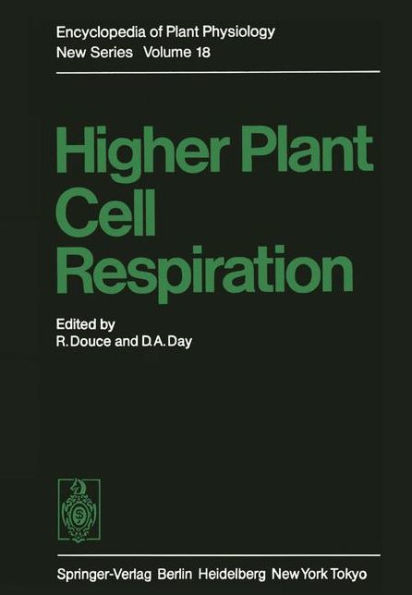5
1

Higher Plant Cell Respiration
524
by R. Douce (Editor), H. Beevers (Foreword by), D.A. Day (Editor)
R. Douce

Higher Plant Cell Respiration
524
by R. Douce (Editor), H. Beevers (Foreword by), D.A. Day (Editor)
R. Douce
Paperback(Softcover reprint of the original 1st ed. 1985)
$109.99
-
PICK UP IN STORECheck Availability at Nearby Stores
Available within 2 business hours
Related collections and offers
109.99
In Stock
Overview
I am honored by the editor's invitation to write a Preface for this volume. As a member of an older generation of plant physiologists, my lineage in plant respiration traces back to F. F. BLACKMAN through the privilege of having M. THOMAS and W. O. JAMES, two of his "students," as my mentors. How the subject has changed in 40 years! In those dark ages B. 14C. most of the information available was hard-won from long-term experiments using the input-output approach. Respiratory changes in response to treatments were measured by laborious gas analysis or by titration of alkali from masses of Pettenkofer tubes; the Warburg respir ometer was just beginning to be used for plant studies by pioneers such as TURNER and ROBERTSON. Nevertheless the classical experiments of BLACKMAN with apples had led to important results on the relations between anaerobic and aerobic carbohydrate utilization and on the climacteric, and to the first explicit concept of respiratory control of respiration imposed by the" organization resistance" of cell structure. THOMAS extended this approach in his investi gations of the Pasteur effect and the induction of aerobic fermentation by poi sons such as cyanide and high concentrations of CO , JAMES began a long 2 series of studies of the partial reactions of respiration in extracts from barley and YEMM'S detailed analysis of carbohydrate components in relation to respira tory changes added an important new dimension.

Product Details
| ISBN-13: | 9783642701030 |
|---|---|
| Publisher: | Springer Berlin Heidelberg |
| Publication date: | 11/25/2011 |
| Series: | Encyclopedia of Plant Physiology , #18 |
| Edition description: | Softcover reprint of the original 1st ed. 1985 |
| Pages: | 524 |
| Product dimensions: | 6.69(w) x 9.61(h) x 0.04(d) |
Table of Contents
1 Preparation of Plant Mihondria, Criteria for Assessement of Mihondrial Integrity and Purity, Survival in Vitro.- 1 Introduction.- 2 General Considerations for the Isolation of Intact Mihondria.- 3 Large-Scale Preparation of Washed Mihondria.- 4 Assessment of Mihondrial Integrity.- 5 Control of Mihondrial Purity.- 6 Purification of Plant Mihondria.- 7 Concluding Remarks.- References.- 2 Molecular Organization and Expression of the Mihondrial Genome of Higher Plants.- 1 Introduction.- 2 Physicochemical Characterization.- 3 Restriction Analysis and Molecular Cloning.- 4 Identified Mihondrial Genes.- 5 Concluding Remarks.- References.- 3 Plant Mihondrial Lipids: Structure, Function and Biosynthesis.- 1 Introduction to Lipid Structures.- 2 Composition of Mihondrial Membranes.- 3 Metabolism.- 4 Functional Aspects of Lipids.- 5 Conclusion.- References.- 4 Plant Mihondrial Cyhromes.- 1 Introduction.- 2 Cyhrome Estimation.- 3 Mihondrial Cyhromes in Higher Plants.- 4 Influence of the Membrane Potential on the Redox States of the Mihondrial Cyhromes.- 5 Miscellany.- 6 Cyhromes in the Respiratory Chain of Higher Plant Mihondria.- References.- 5 The Outer Membrane of Plant Mihondria.- 1 Perspective.- 2 Isolation of Mihondrial Membranes.- 3 Lipid Composition of the Mihondrial Outer Membrane.- 4 Enzymes of the Mihondrial Outer Membrane.- 5 Channel-Formers of the Outer Mihondrial Membrane.- References.- 6 Organization of the Respiratory Chain and Oxidative Phosphorylation.- 1 Introduction.- 2 Organization of Respiratory Components.- 3 Connection Between the Functional Units.- 4 Oxidative Phosphorylation.- References.- 7 The Oxidation of NADH by Plant Mihondria.- 1 Introduction.- 2 NADH Dehydrogenases Oxidizing Exogenous NADH.- 3 NADH Dehydrogenases Oxidizing Endogenous NADH.- References.- 8 The Cyanide-Resistant Pathway of Plant Mihondria.- 1 Introduction.- 2 The Measure of Cyanide Resistance.- 3 The Dependence on Respiratory Substrates.- 4 The Inhibition of Electron Transport.- 5 The Link with Energy Transduction.- 6 The Structure of the Alternative Pathway.- 7 The Functional Organization of the Alternative Pathway.- 8 The Alternative Pathway Oxidase.- 9 The Distribution of Electrons Between the Two Pathways.- 10 The Biogenesis of the Alternative Pathway.- 11 The Significance of the Alternative Pathway.- 12 Conclusion.- References.- 9 Membrane Transport Systems of Plant Mihondria.- 1 Introduction.- 2 Structural and Osmotic Properties.- 3 Techniques of Measuring Transport.- 4 Transport of Inorganic Ions and Acetate.- 5 Transport of Organic Metabolites and Cofactors.- 6 Conclusions.- References.- 10 The Tricarboxylic Acid Cycle in Plant Mihondria: Its Operation and Regulation.- 1 Introduction.- 2 Control.- 3 Fatty Acid Oxidation.- 4 Malate Oxidation: Malate Dehydrogenase or NAD-Malic Enzyme?.- 5 Glycine Oxidation.- 6 Physiological Control of the TCA Cycle.- 7 List of Enzymes.- References.- 11 Leaf Mihondria (C3 + C4 + CAM).- 1 Introduction.- 2 Effects of Light on Dark Respiration.- 3 Preparation of Leaf Mihondria.- 4 Properties of Isolated Leaf Mihondria.- 5 Special Functions of Leaf Mihondria — Role in Photorespiration.- 6 Special Functions of Leaf Mihondria — Role Relative to Decarboxylations in the C4 Cycle.- References.- 12 Starch and Sucrose Degradation.- 1 Introduction.- 2 Properties of Starch and Sucrose.- 3 Degradation of Starch and Sucrose.- 4 Relation Between Carbohydrate Mobilization and Respiration in Various Plant Tissues.- 5General Features of the Control of Carbohydrate Respiration.- References.- 13 The Organization of Glycolysis and the Oxidative Pentose Phosphate Pathway in Plants.- 1 Introduction.- 2 Reactions of Glycolysis.- 3 Reactions of the Oxidative Pentose Phosphate Pathway.- 4 Location and Inter-relationship of Glycolysis and the Oxidative Pentose Phosphate Pathway.- References.- 14 Respiration in Intact Plants and Tissues: Its Regulation and Dependence on Environmental Factors, Metabolism and Invaded Organisms.- 1 Introduction.- 2 Respiration Associated with Growth, Maintenance and Ion Uptake.- 3 Cyanide-Resistant Respiration: Its Distribution and Physiological Significance.- 4 Regulatory Aspects of Respiration in Vivo.- 5 Respiration and Its Relation to Other Aspects of Metabolism.- 6 Respiration and Its Dependence on Environmental Factors.- 7 Respiration and Its Relation to Yield and the Plasticity of the Individual.- 8 Developmental Aspects.- 9 Host-Parasite and Symbiotic Associations.- 10 Concluding Remarks.- References.- Author Index.From the B&N Reads Blog
Page 1 of
